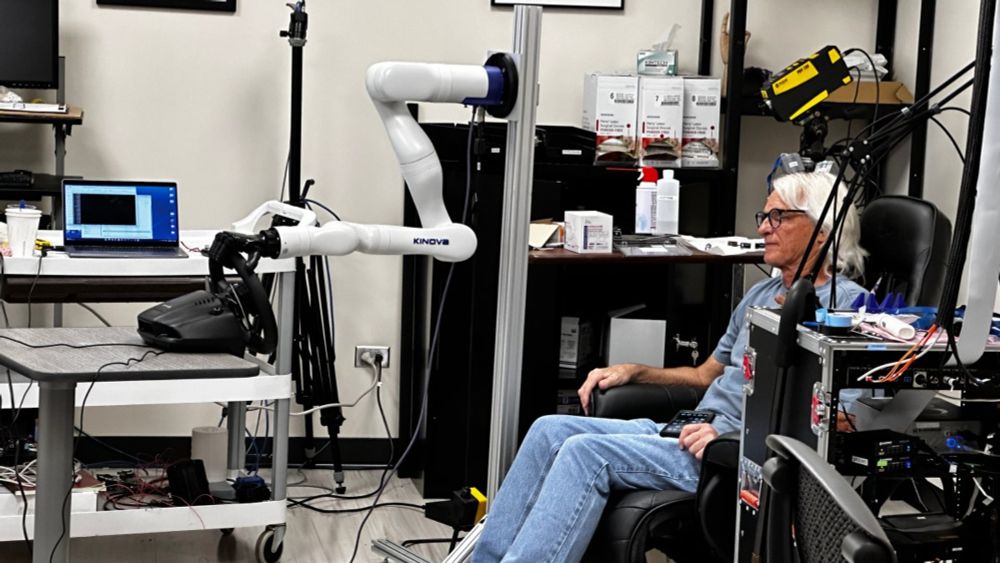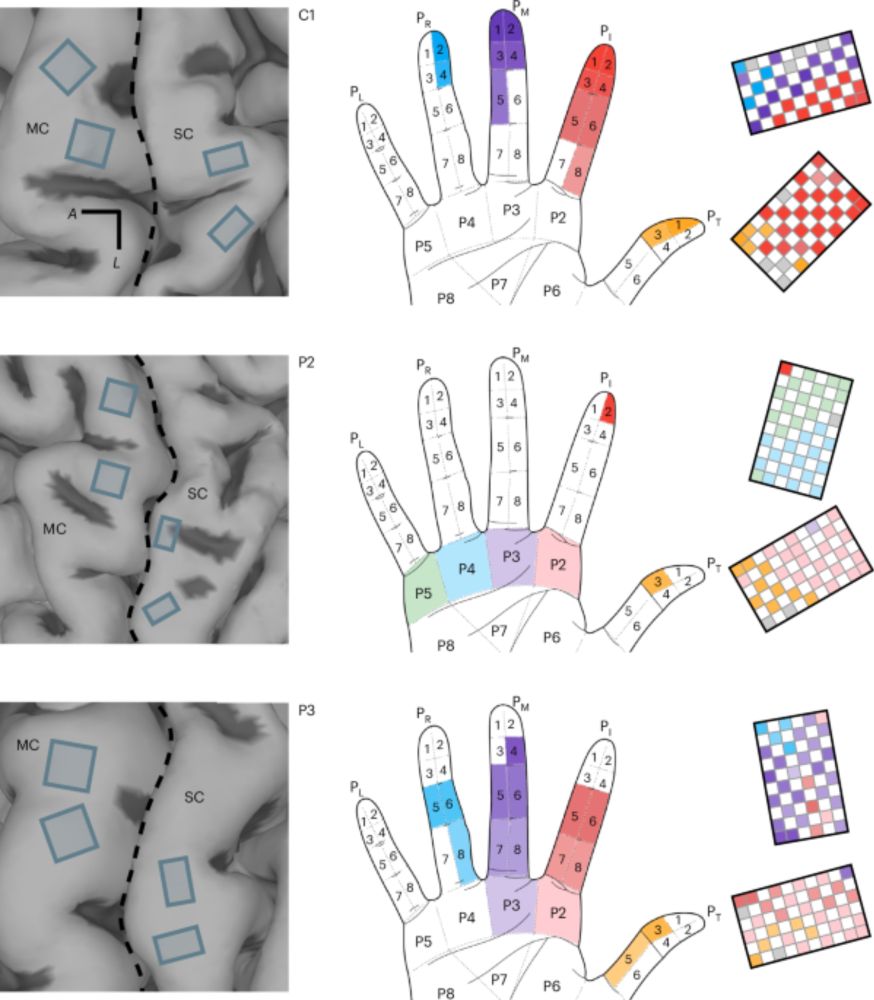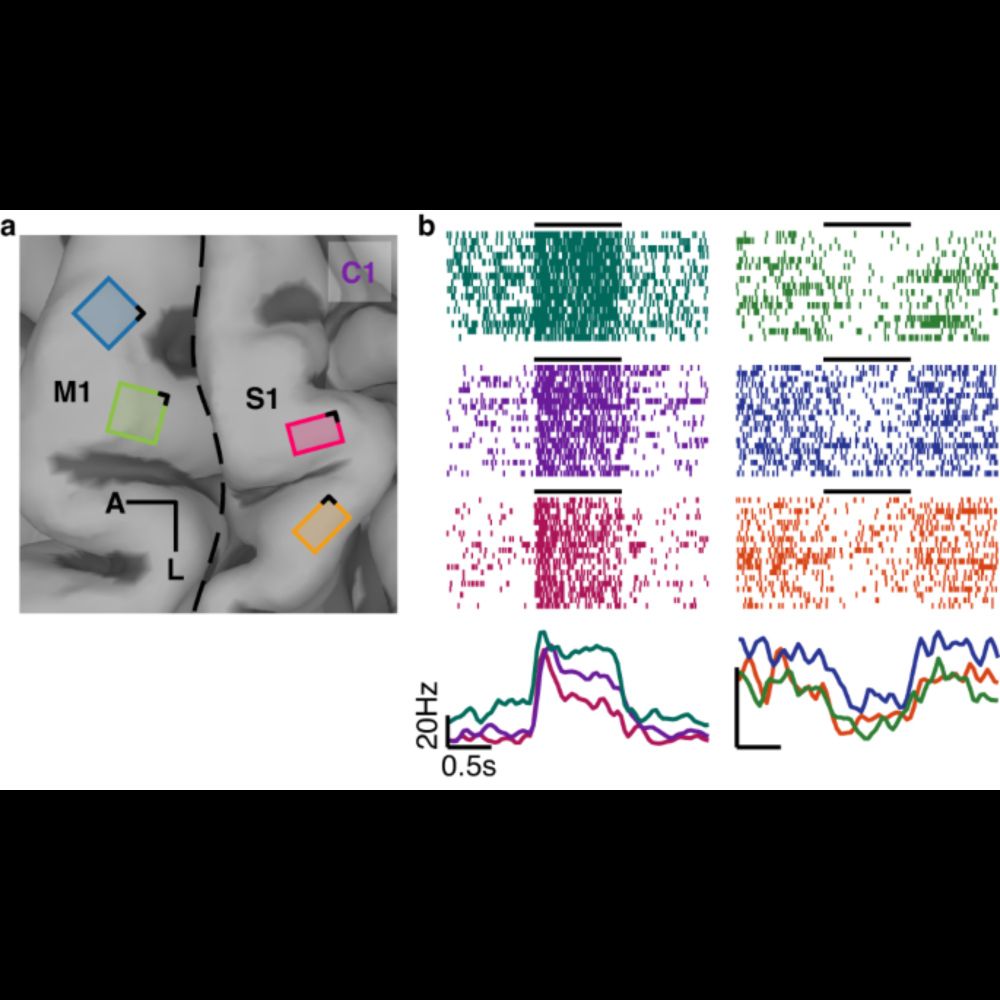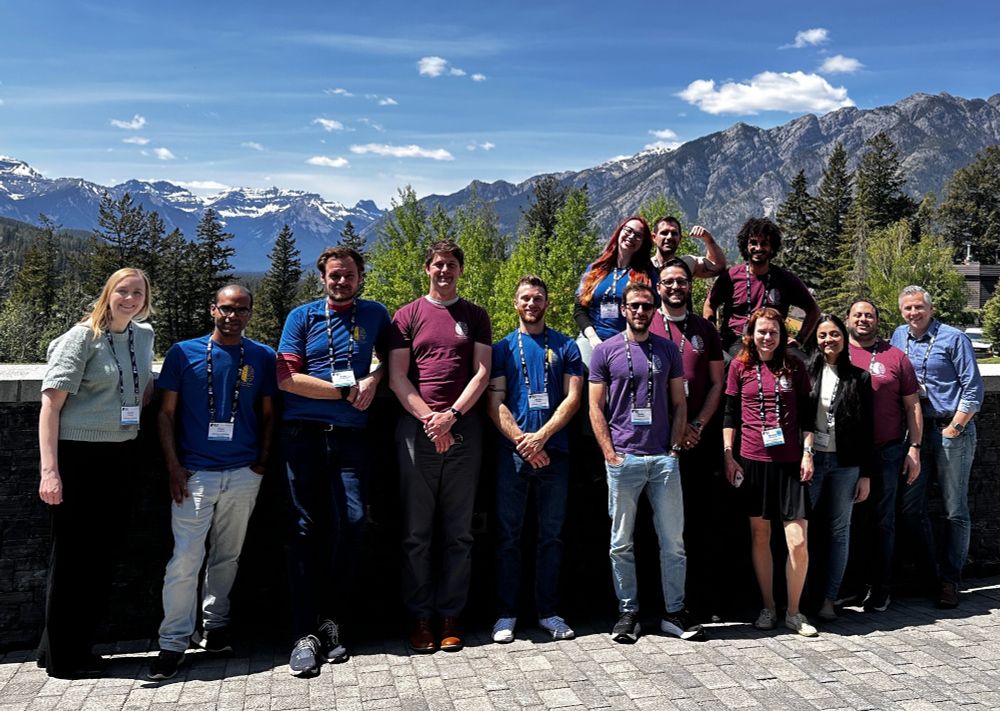
The current and former CBRG members who attended the BCI Society Meeting, gathered together in front of a spectacular mountain view.
We had a great time at the @bcisociety.bsky.social meeting in Banff, Canada. We gathered almost all (@hunterschone.bsky.social?) the CBRG attendees (current and former) for the official photo.
@jenpitt.bsky.social @giacomovalle.bsky.social @johndowney.bsky.social @miskarous.bsky.social
09.06.2025 16:49 — 👍 11 🔁 2 💬 0 📌 0
These results are an important step towards invoking accurate sensation of touch on a person’s paralyzed hand and creating an artificial limb that seamlessly integrates into a person’s unique sensory world.
Great work by the whole CBRG team, and a big thank you to our dedicated participants.
07.05.2025 15:35 — 👍 0 🔁 0 💬 0 📌 0

The screen presented during the object identification task. Participants could "touch" the blank box, then identify which object it is from the silhouettes presented at the bottom.
The sensations were then replayed, without seeing the object, and they could still identify the object, albeit with mistakes. They often mistakenly selected objects with similar properties (cats and towels are both soft), suggesting that the sensations contained intuitive object features.
07.05.2025 15:35 — 👍 0 🔁 0 💬 1 📌 0
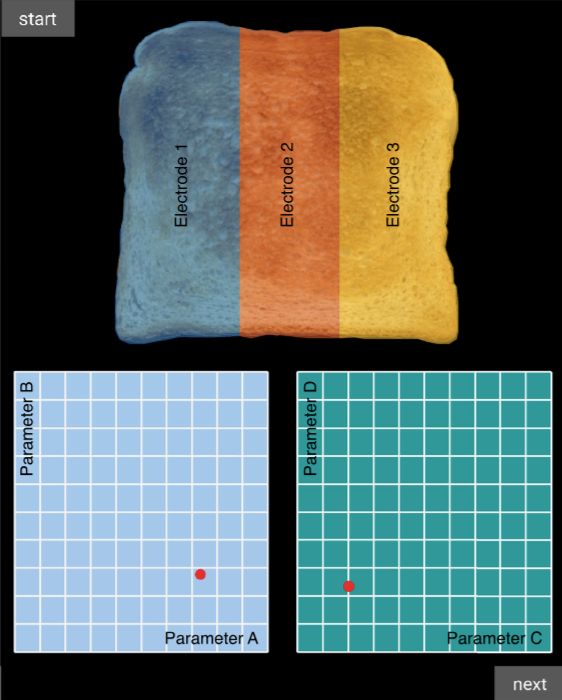
An image of the test setup. When participants could move the red dots in 2 2D planes to change 4 stimulation parameters to which they were blinded. Then they, or an assistant, could touch the digital object and trigger stimulation with the selected parameters on the electrodes to feel if it matched their expectations of the object.
Participants saw an object and edited parameters of their artificially created sense of touch to match. Participants described, e.g., the warm fur of a purring cat, or the smooth rigid surface of a door key.
07.05.2025 15:35 — 👍 0 🔁 0 💬 1 📌 0
Check out @giacomovalle.bsky.social's summary of our new paper showing the details that we can convey to BCI users through spatio-temporally patterned stimulation in somatosensory cortex. This is a great step towards restoring natural sensation from future prosthetic hands.
17.01.2025 15:55 — 👍 5 🔁 0 💬 0 📌 0

Our paper examining the #ethical and #technical requirements in clinical trials for implantable neural prostheses is out in #LancetDigitalHealth today.
www.thelancet.com/journals/lan...
Neural Bionics Lab Chalmers University of Technology @corticalbionics.bsky.social #neuroprosthetics
10.01.2025 10:03 — 👍 9 🔁 4 💬 0 📌 0

Progression of implant plan from placement map, to surgical image, to stimulation results.
Our new publication in Human Brain Mapping is a roadmap to implanting stimulation electrodes to evoke tactile sensations on the fingers of Brain-Computer Interface (BCI) users. We share the plan and results for 5 study participants across a decade at 2 sites.
onlinelibrary.wiley.com/doi/10.1002/...
30.12.2024 20:00 — 👍 11 🔁 3 💬 1 📌 1
Marc Schieber has published his insightful thoughts on the below paper and where it fits in the broader efforts towards dexterous neuroprosthetic hands in Nature BME:
www.nature.com/articles/s41...
19.12.2024 18:40 — 👍 4 🔁 1 💬 0 📌 0
This was a big team effort by the labs, and especially the study participants, across three universities (UChicago, Pitt, and a guest appearance from Case Western). These results a big step forward as we continue to improve the capabilities of ICMS to restore tactile sensations post-injury.
09.12.2024 15:27 — 👍 0 🔁 0 💬 0 📌 0
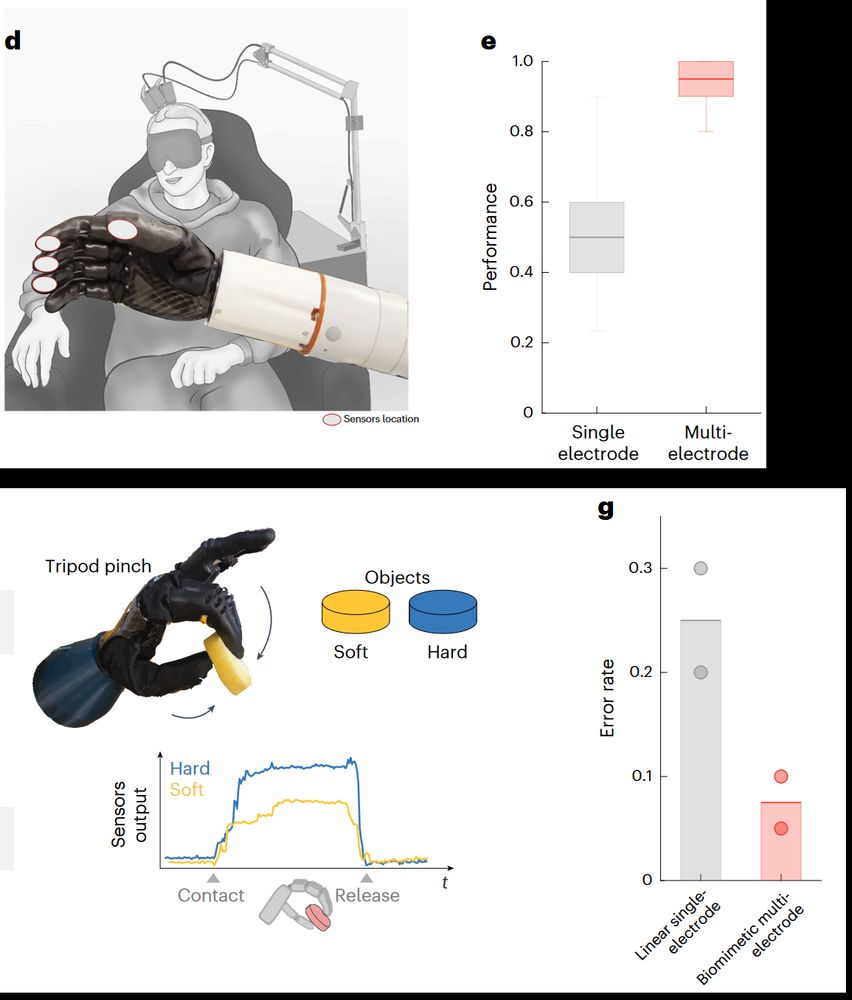
Figure showing how the above findings improve the utility of sensors on a robotic hand by increasing sensation clarity on the fingers and enabling detection of object softness when grasping.
These interactions allowed us to improve the ability of participants to both locate which finger an object was contacting as well as how much force was being applied to it.
09.12.2024 15:27 — 👍 0 🔁 0 💬 1 📌 0
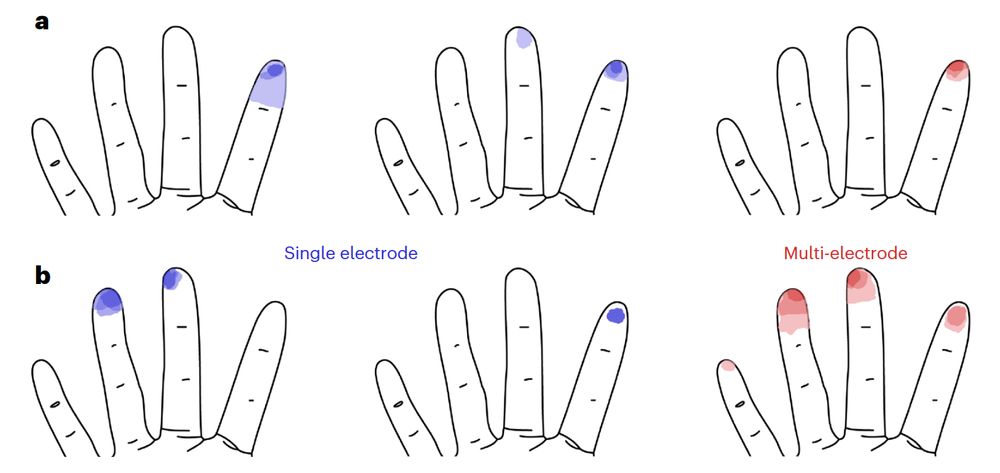
Figure showing that stimulating two electrodes at once evokes a sensation that approximates the sum of the sensations when each electrode is stimulated independently.
Given that some electrodes overlapped, we examined the interaction and found that they generally summed together making more intense sensations.
09.12.2024 15:27 — 👍 0 🔁 0 💬 1 📌 0

Figure showing that electrodes that record activity when a part of the hand is touched, evoke a sensation in the same area of the hand when stimulated.
We compared the percept locations with receptive field locations (area on the hand that when touched evokes neural activity near an electrode) when possible and found that the vast majority of percepts fell within the matched receptive fields.
09.12.2024 15:27 — 👍 0 🔁 0 💬 1 📌 0

A figure from the linked paper, showing where participants feel sensations during electrical stimulation, and that the locations are stable over time.
We first looked to see if ICMS-evoked percepts (a sensation caused by stimulation on an electrode) were in consistent locations across the duration of the study and found that across 2-7 years they were.
09.12.2024 15:27 — 👍 0 🔁 0 💬 1 📌 0
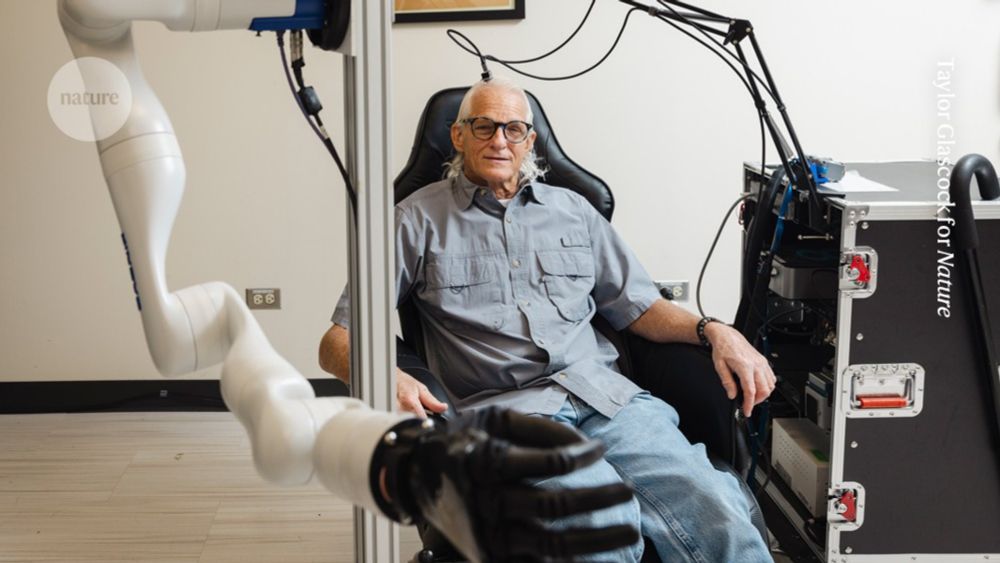
The quest to build bionic limbs that feel like the real thing
Through brain implants, neural interfaces and skin grafts, researchers are starting to restore sensation for paralysed or amputated limbs.
There's a great new story out today in Nature about the state of sensory neuroprosthetic research. It features one of our participants from the University of Chicago and glimpses of exciting research from around the world.
www.nature.com/articles/d41...
12.11.2024 16:02 — 👍 5 🔁 2 💬 0 📌 0
We are seeking a postdoc to work in sensorimotor neuroscience with brain-computer interfaces (BCI). The projects will focus on dexterous hand control through neural recordings and restoration of sensation to neural stimulation.
29.02.2024 21:28 — 👍 3 🔁 2 💬 1 📌 0
University of Pittsburgh Rehab Neural Engineering Labs
Postdoc in the Collinger Lab, RNEL, University of Pittsburgh.
Upper Limb Motor Control, Sensorimotor Communication, and Brain Computer Interface 🦾 🧠
Professor, Rehab Neural Engineering Labs, University of Pittsburgh
Neural engineer passionate for neuroscience, innovations and technology | Lab: @BionicsNeural
Associate Professor, BCI researcher, UMC Utrecht Brain Center
Assistant Professor of Biomedical Engineering at Marquette / Medical College of Wisconsin
Neural prosthetics and optogenetic approaches for motor restoration in spinal cord injury.
Part time ninja warrior, full time child to both my wife and kids.
Akhtar and Bhutta Endowed Professor at Carnegie Mellon University, Department of Mechanical Engineering and the Neuroscience Institute. Co-founder and CTO of Reach Neuro, Inc.
Associate Professor at University of Chicago, Computer Science. Runs the Human-Computer Integration Lab (https://lab.plopes.org) & also a musician.
We’re the Plasticity Lab at Cambridge University, led by Tamar Makin. We study the neural basis of hand function and dysfunction, exploring how technology can enhance movement functionality for able and disabled individuals of all ages: plasticity-lab.com
Neuroscience of dexterous motor control and muscle dynamics
Civic tech, social computing, online communities, comp social science
Previously: comp neuro, analytics (Bensmaia Lab @UChicago, Fulbright@LMU Munich, Bluebonnet Data, Amazon)
Boston -> Chicago -> Munich -> ...
Associate Professor of Physical Medicine & Rehabilitation and Bioengineering at University of Pittsburgh
Assistant Prof @PittNeurosurg & @RNELabs #Neuroscience #Neurotech #Paralysis Founder of @ReachNeuro. What I love most of Science? my friends! 💙 Opinions my own; marcocapo.com
Neural engineer: Spinal cord stimulation⚡️, sensorimotor systems, control, rehabilitation🦿👩🦽🚶♀️ Thoughts=mine
Neuroscience to improve the human condition
Neuroscientist studying how we move
Physiatrist, neuroscientist, gait and movement, brain and robotics enthusiast. Assistant Professor at Northwestern and Shirley Ryan AbilityLab
Computational neuroscientist interested in how we learn, and dad to twin boys
Asst prof at Baylor College of Medicine
https://www.henniglab.org/




